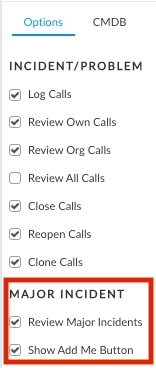Use Cases - Setup Major Incident Management
You can setup Major Incident management easily in ASM
To setup MI Management you simply need to
Create an MI template (Call Template)
Enable access to selected Self Service Portal Security Roles
Configure notifications (message templates), if you will not be using the defaults
Ensure the MI Widget is visible on the SSP
Create a MI template
You will need to have an MI Call template. To do this, ensure you have:
Enabled the MI IPK Status
Linked the MI Call screen (if different from your standard call screen) to the MI IPK Status - Link Stream and Status to Call screen Set
Create the Call template
Enable Access to MI to your Selected SSP Security Roles
Even if you configure MI Management, your SSP users will not be able to access it unless you grant them access. To grant access you will need to:
Access the self service portal Roles - Options Tab and select Review Major Incidents and the Show Add Me Button options.

Configure notifications (message templates), if you will not be using the defaults
By default ASM has preconfigured messgae templates. By default, the message that will go out to users is Called Logged to User.

You can update them for your organization's specific branding and language.
You can create a custom Major Incident Message template and then add it to the message type mapping so that it will be used instead of the default call logged template.
Create a new message template in screen designer linked to the Major Incident Call screen set.
Access message type mapping for 1026 - Call - Logged in Self Service Portal to User
Add the Major Incident message template to the Template List and configure the subject as needed. See also:
Ensure the MI Widget is visible on the SSP
You will need to also ensure the MI widget has not been hidden on the SSP home page.
Access screen designer and locate the widget. Click it so that it has the focus and ensure the properties are not hidden.

Managing MI
Managing an MI is a centralized process. Because users can add themselves, support need only work a single ticket, that is, the MI itself. All related tickets will be linked as children to the MI. When the MI is closed, support will be able to simultaneously close and notify all impacted users.
See the following for more information on managing linked tickets, converting incidents, KE and Problems to Major Incidents and Cloning to MI:
Was this helpful?
